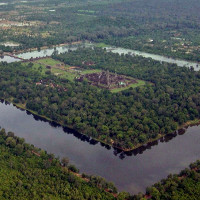Imagine you go to a football game and find that the crowd there is watching the match in deadly silence. Where has all the hustle and bustle gone? If you want some quiet, watch the game at home on TV. That’s why when people think of the stadium, they think of the noise, to the point of tinnitus after every game!
Noise-producing instruments such as horns and horns, vuvuzela (an African type of horn), trumpets and drums add to the collective sound of the fans.

The vuvuzela at the 2010 South Africa World Cup.
The collective sound we hear inside the stadium is what we call the “stadium atmosphere” . An engaging atmosphere at a sports stadium can make a big difference for both the players on the field and the spectators in the stands. However, it is not easy to design reverberations that can create a sense of buzzing magic in the crowd.
The world’s best football stadiums, such as Barcelona FC’s Nou Camp, Real Madrid’s Santiago Bernabeu, Bayern Munich’s Allianz Arena and many others have specially designed their reverbs to capture noise and energy. The best from the crowd.

The oval Nou Camp pitch is very effective at containing the noise of the crowd.
A lively crowd enhances the home team’s effectiveness and intimidates opponents.
Creating atmosphere is more than just making the loudest noise possible. The new generation of stadiums incorporates design features that enhance fan cheering by keeping and amplifying crowd noise. You would think that the bigger the crowd, the louder the noise, which is partly true. To maximize sound intensity, however, it is important to keep the size of the stadium as small as possible and provide reflective surfaces that can push noise back into the crowd. Since the sound fades as you move, it’s important to keep the venue small and isolated.

Most football stadiums in Europe have partial roofs, which help reflect sound waves back to the crowd.
Another way to amplify sound is to use materials such as wood and metal , which increase the reverberation, thus increasing the sound of the crowd. The hollowness of the wood helps the sound to reverberate inside. This allows the crowd on one end to hear the opponent on the opposite side.
The new Al Bayt stadium under construction for the 2022 FIFA Olympics in Qatar is designed with the mission to resonate. It is designed based on a unique tent model, where noise and fan chants are kept inside. One focus of the architectural team was to reflect and test the intensity of sound in the stadium so that it was not too jarring for those inside.
Essentially, the key to achieving optimal noise levels without being too dependent on the fans is to equip the stadium walls with plenty of reflective surfaces. These surfaces must be made of a material that provides optimal sound reflection, along with durability over time.

